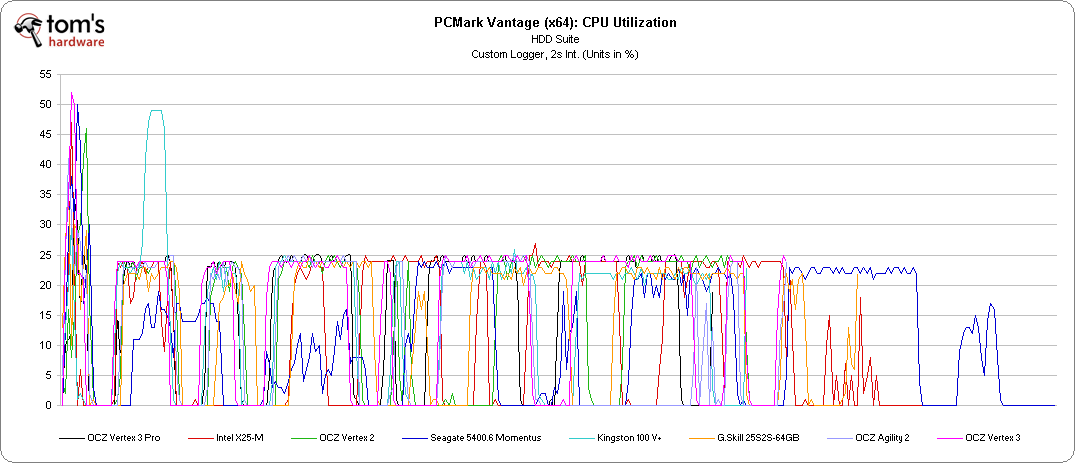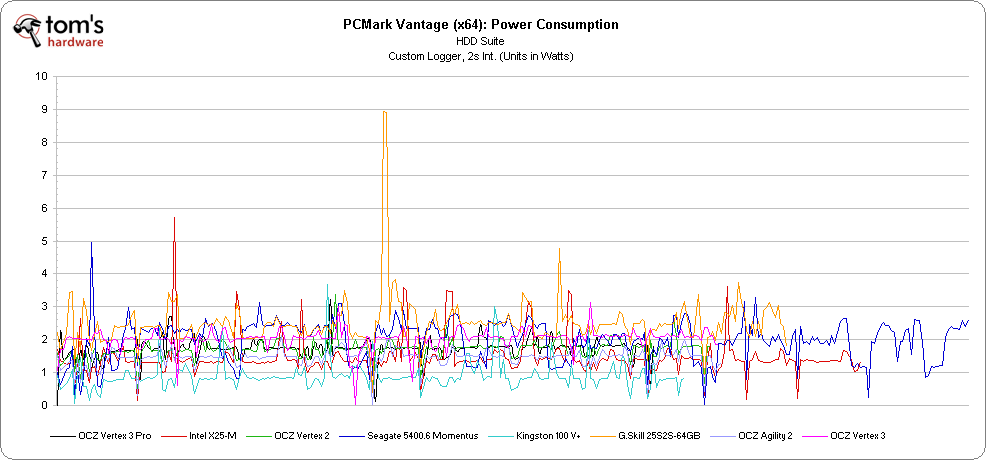OCZ's Vertex 3: Second-Generation SandForce For The Masses
Benchmark Results: Power Consumption
Our benchmark configuration still consists of a smart battery that allows us to measure DC power consumption on the +5 V and +12 V power rails. The next configuration isn't quite ready yet. However, it will allow us to also measure the +3.3 V rail, which means we will be able to compare the VelociRaptor.
The power consumption results for the Vertex 3 line up with our expectations. OCZ claims it turned up performance a bit, which we saw in the preceding benchmarks. As a result, our benchmark confirms a slightly more aggressive use of power.
Even though our results show that the Vertex 3 consumes more power than the Seagate's Momentus, we have to take time into account. A disk-based drive will always consume more power absolutely. At the system level, a SSD will increase power consumption because CPU and memory utilization rises in response to improved I/O activity (they're not sitting there, waiting on a hard drive to send data). But remember that a SSD-based configuration will always finish those operations faster. At the end of the day, a SSD lowers power consumption.
| PCMark Vantage (x64) HDD Suite | Average Power Rating (W) | ActualPower Used (mW) | AverageCPU utilization (%) | Completion Time (mm:ss) |
|---|---|---|---|---|
| Kingston SSDNow 100 V+ | 0.6 | 85 | 14.7 | 8:06 |
| OCZ Agility 2 | 1.4 | 186 | 10.9 | 7:54 |
| Intel X25-M | 1.4 | 242 | 10.8 | 10:17 |
| OCZ Vertex 3 Pro | 1.6 | 207 | 15.1 | 7:41 |
| OCZ Vertex 2 | 1.9 | 269 | 13.9 | 8:28 |
| Seagate Momentus 5400.6 | 2.2 | 426 | 10.4 | 11:40 |
| OCZ Vertex 3 | 2.3 | 305 | 15.1 | 7:50 |
| G.Skill SATA II FM-25S2S-64GB | 2.6 | 369 | 13.5 | 8:40 |
Get Tom's Hardware's best news and in-depth reviews, straight to your inbox.
Current page: Benchmark Results: Power Consumption
Prev Page Benchmark Results: PCMark Vantage Storage Test Next Page Final Words-
lradunovic77 I agree and it is time for HDD to be retired. We don't need them anymore, but Servers.Reply -
bildo123 A far cry as far as "the masses" are concerned. Still, over $2/GB is too much. Getting closer however. I'd pay $200 for a 256GB SSD with these speeds.Reply -
acku mayankleoboy1the fact that they use ~15% of a quad core SB CPU, is amazing.with the mechanical drives, they were just sitting idle. this more than anything, makes the SSD worthwhile.Reply
Well what I didn't mention in the review is that the benchmark starts as ~20% across all cores during the first 10 seconds, which is from PCMark setting up the disk trace. After that, the IO activity throttles a single core up to 100% for almost all SSDs. For the hard drives, we see ~60-80% utilization of a single core.
Cheers,
Andrew Ku
TomsHardware.com -
lradunovic77 I say keep your desktop active all the time. I am running i980x overclocked to 4.0Ghz and there is no way i will put my computer into any type of power saving mode, it is useless and power saving is just mimick. We are talking about very small amount of money over a year. Having Turbo option makes sense from certain point of view but bottom line is that it is just wasted silicon and pretty much useless.Reply -
vvhocare5 "The problem is that any price above $2/GB is going to be a hard sell unless you're an early adopter by nature. Our choices in recent System Builder Marathon stories reflect this. Look at our December $1000 PC."Reply
Overall a good article. Anyone into MTBF's will find that one page uninforming and anyone not into it is likely lost.
I would disagree with that statement only in the sense that a $1000 PC is not going to be filled with high-end superior performing parts. So I dont see a reason to apologize for its price. The person who can afford a $3000+ PC isnt going to blink buying the 240G model and will likely see it as entirely reasonable.
Me? I think I have found my next ex-drive.....
-
acku Replyso as i said, will OC increase the scores a bit?
and what about power saving enabled?
None of our tests were executed in an environment that allowed any idling. Furthermore, we disabled CPU throttling. Power saving was enabled in the sense that the display was allowed to turn off, which is part of the default profile in Windows.
OCing may increase performance, but only to the extent that the bandwidth will support it. As I mentioned, PCMark throttles a single core up to 100%. It isn't a sustained trend. -
bto on your 1000 dollar gaming system, I'd rather have a vertex 3 than two 460's hell even an agility 2... and still afford better than a 460.Reply -
bto But then that's me, and to quote the great Inigo Montoya, "I hate wait" and most games I play are not bleeding edge, I also work on my computer, play HD movies and copying time makes me angry when I'm moving files. Buy an ssd, and later spend 60 bux on a 1tb drive down the road.Reply

